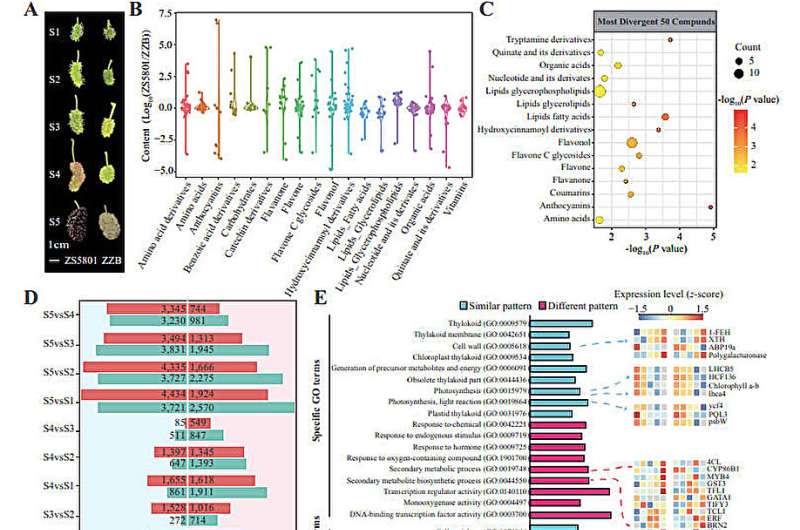
Unlocking the genetic secrets of mulberry anthocyanin content, a study illuminates the regulatory mechanisms that dictate fruit color and nutritional quality. By assembling and analyzing the genomes of two distinct mulberry cultivars, researchers have pinpointed key genetic variations and the pivotal role of MaVHAG3 in anthocyanin accumulation, offering a biotechnological blueprint for enhancing fruit traits.
Mulberry fruits are celebrated for their vibrant colors, nutritional value, and potential health benefits. Anthocyanins, the primary pigments in purple mulberries, are known for their antioxidant properties and role in human health. However, understanding the genetic basis of anthocyanin regulation in mulberry fruits has been challenging due to their complex genomes. Based on these challenges, there is a pressing need for in-depth research to better understand and manipulate mulberry fruit pigmentation.
On April 23, 2024, researchers from Southwest University in Chongqing, China, published a pivotal study in Horticulture Research. The team generated haplotype-resolved genome assemblies for two mulberry cultivars, “Zhongsang5801” (high anthocyanin) and “Zhenzhubai” (low anthocyanin). Their comprehensive analysis identified key genes and regulatory mechanisms underlying anthocyanin content in mulberries, paving the way for genetic enhancement of mulberry cultivars.
The study involved sequencing the genomes of “Zhongsang5801” (ZS5801) and “Zhenzhubai” (ZZB), followed by a detailed comparative analysis of their genomic and transcriptomic data. The researchers identified MaVHAG3, a vacuolar-type H+-ATPase G3 subunit gene, as crucial in anthocyanin accumulation.
By comparing gene expression across developmental stages, they found that ZS5801 exhibited significantly higher levels of anthocyanins and flavonoids compared to ZZB. The analysis also revealed expansions and contractions in flavonol synthase (FLS) and dihydroflavonol 4-reductase (DFR) genes, which impact carbon flow in anthocyanin biosynthesis pathways. These findings highlight the intricate genetic and molecular processes that regulate fruit coloration in mulberries.
Dr. Aichun Zhao, the corresponding author, commented, “Our research provides a comprehensive understanding of the genetic and molecular mechanisms controlling anthocyanin content in mulberries. These insights are critical for developing new cultivars with enhanced nutritional and aesthetic qualities. The high-quality genome assemblies we generated will serve as a valuable resource for future research and breeding programs.”
The findings from this study have significant implications for the agricultural and food industries. By understanding the genetic basis of anthocyanin regulation, breeders can develop mulberry cultivars with higher anthocyanin content, leading to fruits with better nutritional profiles and health benefits.
Additionally, the enhanced pigmentation traits can improve the market appeal of mulberry products. This research also sets the stage for further studies on other fruit crops, potentially leading to broader applications in horticulture and biotechnology.
More information:
Zhongqiang Xia et al, Haplotype-resolved chromosomal-level genome assembly reveals regulatory variations in mulberry fruit anthocyanin content, Horticulture Research (2024). DOI: 10.1093/hr/uhae120
Citation:
Genetic study reveals key to mulberry anthocyanin richness (2024, July 18)
retrieved 18 July 2024
from https://phys.org/news/2024-07-genetic-reveals-key-mulberry-anthocyanin.html
This document is subject to copyright. Apart from any fair dealing for the purpose of private study or research, no
part may be reproduced without the written permission. The content is provided for information purposes only.







